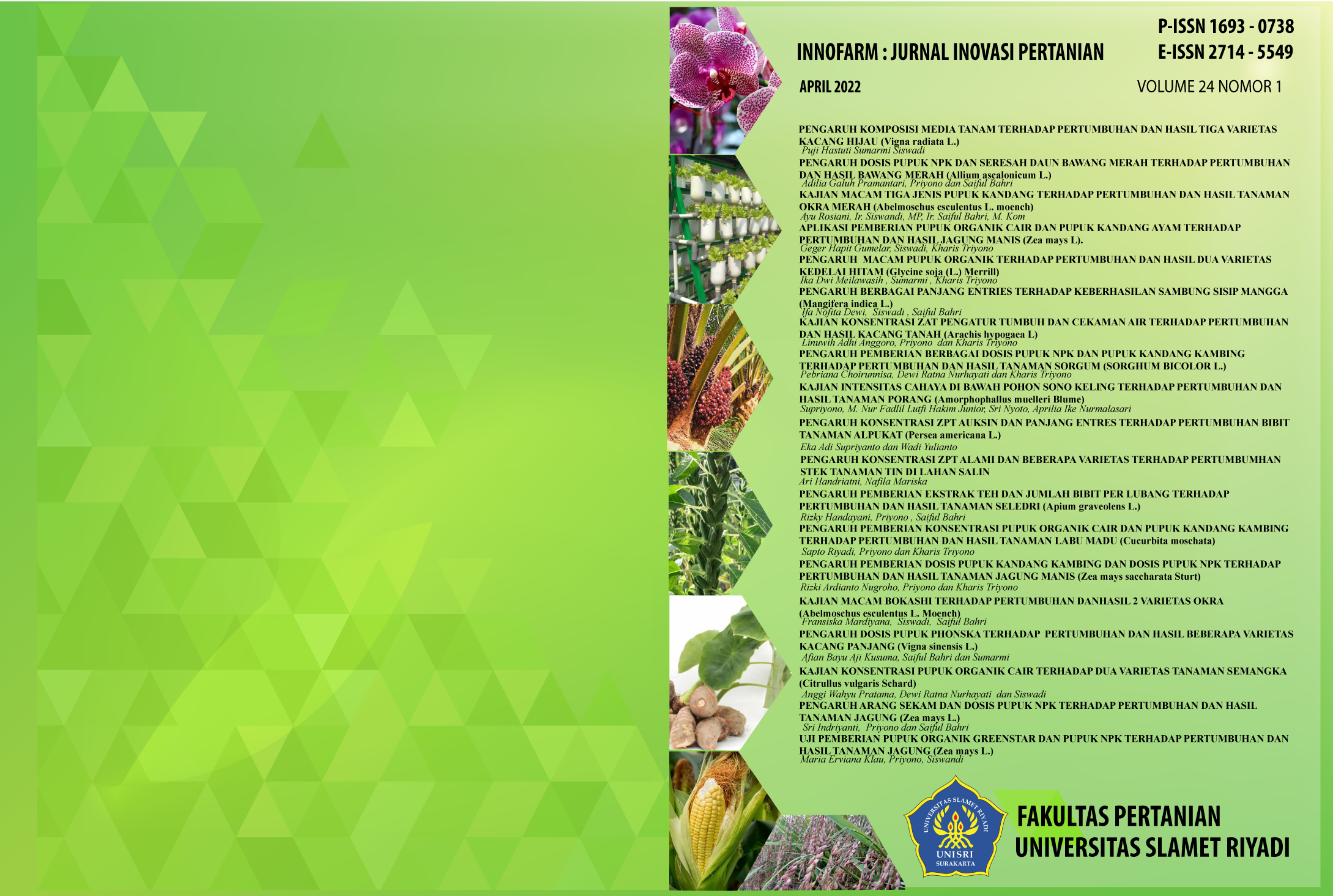STUDY OF CONCENTRATION OF LIQUID ORGANIC FERTILIZER ON TWO VARIETIES OF WATERMONE (Citrullus vulgaris Schard)
OF CONCENTRATION OF LIQUID ORGANIC FERTILIZER ON TWO VARIETIES OF WATERMONE (Citrullus vulgaris Schard)
DOI:
https://doi.org/10.33061/innofarm.v24i1.7299Abstract
Research on the study of the concentration of liquid organic fertilizer on two varieties of watermelon (Citrullus vulgaris Schard) was carried out in June–August 2021. carried out at the Jaya Wijaya ResearchiCenter, Faculty of Agriculture, Slamet Riyadi University, Surakarta, whichiis located in Joglo Village, Banjarsari District, Surakarta City,iCentral Java 57136. This study aims to examine the concentration of liquid organic fertilizer on two varieties of watermelon (Citrullus vulgaris Schard). This study used a Completely Randomized Block Design (RAKL) method which was arranged in a factorial, consists of two factors, namely (1) varieties of watermelon consisting of: Punggawa F1(V1) variety, Baginda F1(V2) variety. (2) the concentration of liquid organic fertilizer consisting of: without liquid organic fertilizer (P0), Concentration of 20 ml/liter of water (P1), Concentration of 40 ml/liter of water (P2), Concentration of 60 ml/liter of water (P3). From the two treatments, 8 combinations were obtained and each combination was repeated 4 times, so there were 32 combinations. Data analysis was used to determine whether there was an effect of the treatment, analysis of variance was used, followed by Duncan's Multiple Range Test (DMRT) at the 5% level. The results showed that the concentration of liquid organic fertilizer on Punggawa F1 watermelon plants had no significant effect on plant length, flower emergence time, wet stover weight, dry stover weight, and fruit length, but it did affect leaf color and fruit circumference. The highest results were the treatment with a concentration of 60 ml/liter of water (P3) was able to produce 3.92 leaf color, 39.75 cm fruit circumference, and treatment with a concentration of 20 ml/liter of water (P2) was able to produce a fruit weight of 1132.58 grams, while the Baginda F1 variety had no significant effect on plant length, flower emergence time, wet stover weight, dry stover weight, and fruit length, but had an effect on leaf color and fruit weight, fruit circumference, the highest yield was at a concentration of 60 ml/liter of water. (P3) was able to produce 4.00 leaf color, 39.75 cm fruit circumference, and 1179.42 gram fruit weigh
Downloads
Published
Issue
Section
License
Copyright (c) 2022 anggi wahyu pratama, Dewi Ratna Nurhayati, Siswadi Siswadi

This work is licensed under a Creative Commons Attribution-NonCommercial 4.0 International License.
Authors who publish this journal agree to the following terms:
- Authors retain copyright and grant the journal right of first publication with the work simultaneously licensed under a Creative Commons Attribution License that allows others to share the work with an acknowledgement of the work's authorship and initial publication in this journal.
- Authors can separately make additional contractual arrangements for non-exclusive distribution published by the journal (e.g., publish it in a book), with an acknowledgement of its initial publication in this journal.
- Authors are allowed and encouraged to send their work via online (e.g., in the institutional repositories or their website) after published by the journal.


















